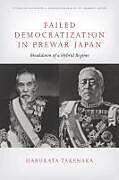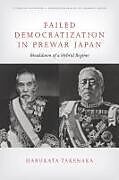Failed Democratization in Prewar Japan
Einband:
Fester Einband
EAN:
9780804763417
Untertitel:
Breakdown of a Hybrid Regime
Genre:
Politikwissenschaft
Autor:
Harukata Takenaka
Herausgeber:
Stanford University Press
Anzahl Seiten:
256
Erscheinungsdatum:
20.08.2014
ISBN:
978-0-8047-6341-7
Zusatztext "This book is a major contribution to the comparative literature on hybrid regimes and to the historical literature on pre-war Japanese politics. Takenaka shows how political leaders' bumbling policy performance and narrow pursuit of short term advantage exacerbated the dilemma of institutionally weak party government and a strong and increasingly politicized and ambitious military. This is a fascinating and important work of political history." Informationen zum Autor Harukata Takenaka is a Professor, at the National Graduate Institute for Policy Studies, Tokyo, Japan. Klappentext Failed Democratization in Prewar Japan presents a compelling case study on change in political regimes through its exploration of Japan's transition to democracy. Within a broad-ranging examination of Japan's "semi-democratic" political system from 1918 to 1932, when political parties tended to dominate the government, the book analyzes in detail why this system collapsed in 1932 and discusses the implications of the failure. By reference to comparable cases-prewar Argentina, prewar Germany, postwar Brazil, and 1980s Thailand-Harukata Takenaka reveals that the factors responsible for the breakdown of the Taisho democracy in Japan replicated those that precipitated the collapse of democracy in Europe, Latin America, and elsewhere in Asia. While most literature on these transitions focuses on successful cases, Takenaka explores democratic failure to answer questions about how and why political parties and their leaders can behave in ways that undermine the democratic institutions that serve as the basis for their formal authority. Zusammenfassung Failed Democratization in Prewar Japan presents a compelling case study on change in political regimes through its exploration of Japan's transition to democracy. Within a broad-ranging examination of Japan's "semi-democratic" political system from 1918 to 1932! when political parties tended to dominate the government! the book analyzes in detail why this system collapsed in 1932 and discusses the implications of the failure. By reference to comparable cases-prewar Argentina! prewar Germany! postwar Brazil! and 1980s Thailand-Harukata Takenaka reveals that the factors responsible for the breakdown of the Taisho democracy in Japan replicated those that precipitated the collapse of democracy in Europe! Latin America! and elsewhere in Asia. While most literature on these transitions focuses on successful cases! Takenaka explores democratic failure to answer questions about how and why political parties and their leaders can behave in ways that undermine the democratic institutions that serve as the basis for their formal authority. Inhaltsverzeichnis Failed Democratization in Prewar Japan: Breakdown of a Hybrid Regime Author(s): Harukata Takenaka How and why does a semi-democratic regimeone that developed as a result of significant degree of democratizationcollapse without experiencing further democratization? This book answers these questions through a case study of the collapse of the semi-democratic regime in prewar Japan. Japan's gradual democratization after the Meiji Restoration in 1867 led to the rise of the semi-democratic regime in 1918. It was characterized by the rule of party government and electoral participation by a significant portion of the population. Confronted with a series of threats from the military, it collapsed in 1932 after the May Fifteenth Incident. This book explains the collapse of this regime as a result of shift in the balance of power between the party government and the military. It focuses on Meiji Constitution's institutional constraints as well as legitimacy and the semi-loyalty of political parties and their memebers as factors that affected the relationship/ Although the Meiji Constitution placed the party...
Autorentext
Harukata Takenaka is a Professor, at the National Graduate Institute for Policy Studies, Tokyo, Japan.
Klappentext
Failed Democratization in Prewar Japan presents a compelling case study on change in political regimes through its exploration of Japan's transition to democracy. Within a broad-ranging examination of Japan's "semi-democratic" political system from 1918 to 1932, when political parties tended to dominate the government, the book analyzes in detail why this system collapsed in 1932 and discusses the implications of the failure. By reference to comparable cases-prewar Argentina, prewar Germany, postwar Brazil, and 1980s Thailand-Harukata Takenaka reveals that the factors responsible for the breakdown of the Taisho democracy in Japan replicated those that precipitated the collapse of democracy in Europe, Latin America, and elsewhere in Asia. While most literature on these transitions focuses on successful cases, Takenaka explores democratic failure to answer questions about how and why political parties and their leaders can behave in ways that undermine the democratic institutions that serve as the basis for their formal authority.
Inhalt
Failed Democratization in Prewar Japan: Breakdown of a Hybrid Regime
Author(s): Harukata Takenaka
How and why does a semi-democratic regime-one that developed as a result of significant degree of democratization-collapse without experiencing further democratization? This book answers these questions through a case study of the collapse of the semi-democratic regime in prewar Japan. Japan's gradual democratization after the Meiji Restoration in 1867 led to the rise of the semi-democratic regime in 1918. It was characterized by the rule of party government and electoral participation by a significant portion of the population. Confronted with a series of threats from the military, it collapsed in 1932 after the May Fifteenth Incident. This book explains the collapse of this regime as a result of shift in the balance of power between the party government and the military. It focuses on Meiji Constitution's institutional constraints as well as legitimacy and the semi-loyalty of political parties and their memebers as factors that affected the relationship/ Although the Meiji Constitution placed the party government in a weak position institutionally with respect to the military, the high legitimacy that it claimed initially enabled it to sustain the regime from the outset. Gradually, however, its legitimacy eroded and political parties became semi-loyal to the regime, tolerating or encouraging the military's challenge against to it. This led to the collapse of the semi-democratic regime.
Introduction
Chapter abstract:
The introduction presents the central question of the book: how and why does a semi-democratic regime collapse without experiencing further democratization? It defines the semi-democratic regime, a subtype of hybrid regimes. It then describes the book's two objectives in answering this question, which it attempts to achieve through a study of the literature on hybrid regimes as well as on prewar Japanese political development. The first is to widen our knowledge of the political dynamics of hybrid regimes. The second is to provide a comprehensive analysis of Japan's political development from the late 1910s to the early 1930s. Lastly, it refers to three comparable cases of semi-democratic regimes: Great Britain in the latter half of 19th century, Brazil between 1945 and 1964, and Thailand between 1978 and 1997.
1
Analytical Foundations
Chapter abstract:
This chapter examines various approaches to analyzing the collapse of semi-democratic regimes. It first examines whether it is possible to apply existing theories of democratization and regime change to explain such a collapse. Then it discusses the problems of these approaches and proposes an alternate analytical framework, arguing that the…

Leider konnten wir für diesen Artikel keine Preise ermitteln ...
billigbuch.ch sucht jetzt für Sie die besten Angebote ...
Die aktuellen Verkaufspreise von 6 Onlineshops werden in Realtime abgefragt.
Sie können das gewünschte Produkt anschliessend direkt beim Anbieter Ihrer Wahl bestellen.
Loading...
Die aktuellen Verkaufspreise von 6 Onlineshops werden in Realtime abgefragt.
Sie können das gewünschte Produkt anschliessend direkt beim Anbieter Ihrer Wahl bestellen.
| # | Onlineshop | Preis CHF | Versand CHF | Total CHF | ||
|---|---|---|---|---|---|---|
| 1 | Seller | 0.00 | 0.00 | 0.00 |
